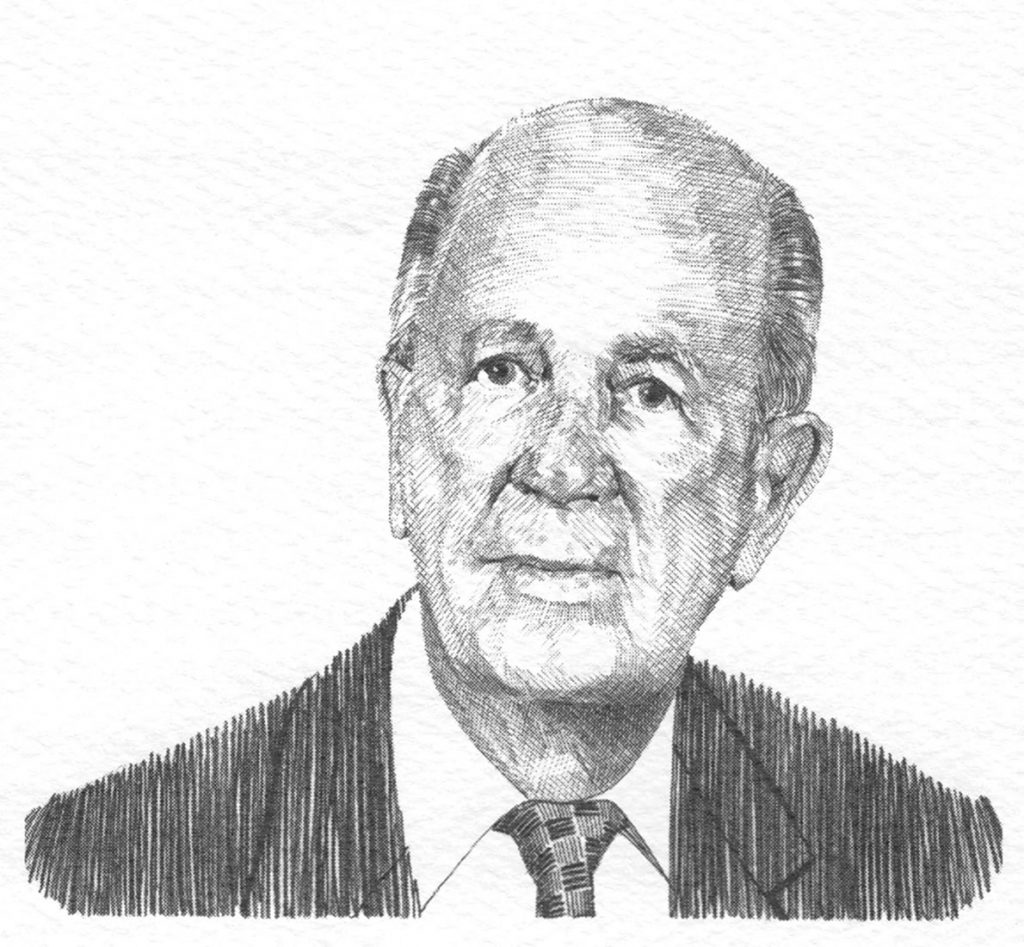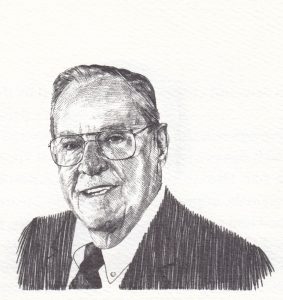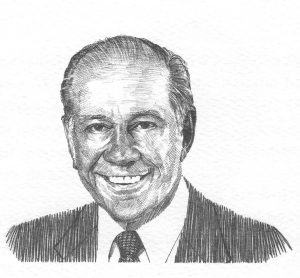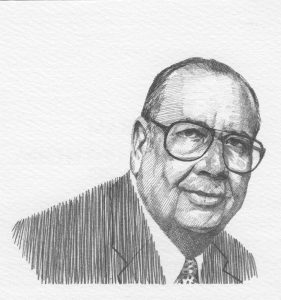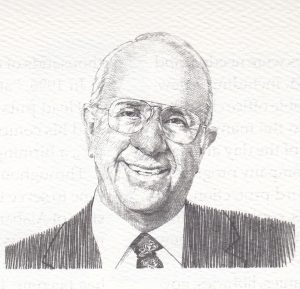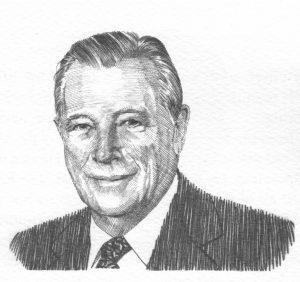Stanley Robbins was born August 19, 1908, in the rough-and-tumble town of Flomaton on the Alabama Florida border, the son of Edward Stanley Robbins and Julia Carolyn Castleberry Robbins.
In the 93 years since, he has become one of the state’s most successful inventors, manufacturers, and businessmen, and built National Floor Products into one of the largest employers in the Shoals area of North Alabama.
The story of E. Stanley Robbins is a true American success story. At age three he was stricken with polio that left his left leg paralyzed. But thanks to the efforts of his mother and six months of crude but effective electric shock treatment, he managed to overcome the illness and begin to walk. He attended school in Castleberry and Evergreen, AL before moving to Mobile, where he graduated from high school. While living in Evergreen, he lost his father in a sawmill accident, which left his mother to raise Robbins and his three siblings, a tough job for a widow in those days.
When Robbins was 10, his family moved back to Castleberry, where his mother began operating a boarding house, and he and a brother went to work summers in a nearby woodworking veneer plant. The boys made seven cents an hour and worked six days a week, 12 hours a day. The family eventually relocated to Mobile, where Robbins painted houses and worked in a grocery store, eventually earning enough money to buy a Model-T Ford, which he planned to drive to Dayton, Ohio, where he had a job waiting.
He and a friend left Mobile in June 1925, camping along the way, and arrived in Dayton a week later. His first job in Ohio was painting a house, but he soon went to work in a plant that manufactured materials used for repairing tires. Robbins put his ingenuity to work and found a number of ways to modernize the plant. He was rewarded in short order by being put in charge of the plant.
Meanwhile, he had started a small tire and inner tube business in St. Louis, which he visited on a regular basis. During his visits to St. Louis, he made friends with a fellow Alabamian, who told him about a bankrupt rubber manufacturing plant in the middle of a cotton field in Tuscumbia, Alabama. That piqued his interest and he went to bid on the plant. He persuaded the bankruptcy judge to let him buy the plant for a penny on the dollar. So in 1930, he returned to Alabama, settling this time in the northern part of the state. He bought the facility and using the knowledge obtained in Dayton, built an inner tube and tire repair facility that eventually employed more than 1,200 people. The plant was destroyed by fire in 1939, but Robbins had it rebuilt in time to supply tubes and retread rubber to the military during World War II.
The new plant, finished in 1940, was at the time the most modern facility of its kind in the world. During the war, the plant was converted from producing natural crude rubber to producing synthetic rubber and became the leading producer of synthetic rubber during the war. Robbins is responsible for the research and development of synthetic rubber that is still used today to make inner tubes.
After the war, Robbins turned his attention to another product, vinyl. He built one of the world’s most modern vinyl plants, Robbins Flooring, a new company. He also designed the equipment that produced the first solid vinyl flooring. He is acknowledged as a pioneer in the industry. He was instrumental in developing high-quality vinyl, solid vinyl flooring, and was the first manufacturer to produce a pure vinyl flooring.
During World War II, Robbins sold Robbins Tire and Rubber plant but remained with the company to run the operation. He left in 1956, and, in 1957, turned all of his efforts toward bringing National Floor Products online. He converted some cattle barns located on Shoal Creek into a 35-employee plant. He later moved the company to the Florence/Lauderdale Industrial Park, where his company was the first to buy property and break ground. There he developed and designed the equipment for one of the most modern resilient flooring plants in the world, which at one time employed more than 500 people. In 1994, NAFCO was sold to the Canadian firm, Domco Industries, and today is a subsidiary of Domco Tarkett, one of the world’s largest manufacturers of resilient flooring.
In 1989, at age 81, Robbins founded a new company, Robbins Industries, located in the Florence/Lauderdale Industrial Park. The company has numerous patents for kitchenware designs and includes the subsidiary, KitchenArt, which designs and markets innovative kitchenware.
As might be expected for an inventor and manufacturer of Robbins’ stature, he holds a number of patents in design and manufacturing. He has designed and developed equipment used to manufacture both rubber and vinyl. He has a patent on precision sizing the tile, processing patents on wall base and he invented the first vacuum-back tile that needs no adhesive for installation.
For the last 72 years, Edward Stanley Robbins has given generously of his time and money for the betterment of the Shoals area. In1974, he was recognized for his efforts by being named Muscle Shoals Citizen of the Year, the area’s highest recognition.
He is a former director and member of the Florence Chamber of Commerce, a member of the Alabama Chamber of Commerce, and the United States Chamber of Commerce. He is one of the original members of the Florence /Lauderdale Industrial Development Committee and has served on the board of directors of the Alabama Mountain Lakes Association. He also was an active supporter of the Associated Industries of Alabama.
Robbins has devoted countless hours to many community projects. He has served on the Salvation Army Board and is a strong and active supporter of the Boy Scouts of America. He is a past member of the Rotary Club of Florence and the Kiwanis Club of Tuscumbia.
He helped organize and served on the board of directors of Sheffield Federal Savings and Loan Association. He also served on the board of State National Bank (now Compass Bank) and on the board of First Federal Savings and Loan Association in Florence. He also served as a member and chairman of the Atlanta Federal Reserve Board, Birmingham Branch.
Robbins has also been a strong supporter of young people and education. He supported the Junior Achievement Program and served on the board of the Quad-Cities Junior Achievement and has been a board member of the Riverhill School. He is the primary benefactor of the YMCA of the Shoals, on whose board he served. The Florence branch of the YMCA is named the E. Stanley Robbins Branch.
He has been a lifelong boating enthusiast and is a founder and former board member of the Turtle Point Yacht and Country Club, and a member of the Guntersville Yacht Club.
He also was one of the moving forces behind the renovation of Tuscumbia’s Spring Park, which included the installation of a waterfall and a fountain.
As might be expected of an inventor, manufacturer, and sailor, Robbins has constructed a unique home on an island at the mouth of Shoal Creek, where he lives with his second wife, the former Martha Rose Wilson of Tuscumbia. The house is equipped with many of his innovations and engineering designs.
Robbins has six children: Edward Stanley, Harvey Frank, John Conrad, Rodney Wilson, Martha Ruth Pillow, and Katrina Robbins Nix.

